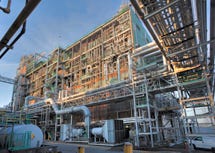Eastman opens expanded Tritan plant, copolyester’s rapid rise continues
Only six years removed from its decision to pursue an abandoned monomer as the key to the high-heat material it had sought at different intervals for decades, Eastman Chemical Co. (Kingsport, TN) marked another important milestone in the whirlwind development of its Tritan copolyester material, with the May 13 opening of a dedicated Tritan production plant at its Tennessee headquarters.
May 14, 2010
Only six years removed from its decision to pursue an abandoned monomer as the key to the high-heat material it had sought at different intervals for decades, Eastman Chemical Co. (Kingsport, TN) marked another important milestone in the whirlwind development of its Tritan copolyester material, with the May 13 opening of a dedicated Tritan production plant at its Tennessee headquarters. "I've been in R&D most of my career, and taking something from lab scale to commercial scale when you have to simultaneously develop a new monomer, a new polymer, and the market, it's just...we had no right to believe we could actually do that, but we did," explained Dante Rutstrom, VP and general manager, specialty plastics business.
|
Eastman's expanded Tritan copolyester line pushes its total capacity over 30,000 tonnes/yr. |
Eastman officials hosted trade and area press, as well as local and regional government officials, to mark the occasion, showing visitors the new production line, as well as the array of now-commercial products Tritan is used in. Including the original developmental line, Eastman now has just over 30,000 tonnes/yr of capacity for Tritan copolyester, all in Kingsport, with plans in place to double that by 2011 to 60,000 tonnes/yr should demand continue to expand at its current pace.
The company said that Tritan business in the past 12 months has quadrupled in dollar and volume terms, with applications expanding beyond the initial markets of reusable sports water bottles, housewares, and small appliances, to now include medical, infant care, bulk water, and signage. Eastman did not disclose its investment to date in the material's launch.
Company officials said that technology development began in earnest in 2004, and after presenting a plan at the corporate level to pursue the new monomer and polymer, a team led by Rutstrom pushed forward starting in 2005 with the simultaneous creation of the monomer and polymer production technologies, as well as market development. The goal was a commercial launch by 2007 at the triennial K show in October in Düsseldorf, Germany. The company reached that goal, and announced its intention to expand production, with those plans coming to fruition in the form of the newly inaugurated line.
Making all of this possible was the work of a handful of researchers, building off an investigation of a new monomer in the late 1950s, early 1960s that Eastman at the time felt could present a path to a high-heat material. That work, led by Robert Hasek, was eventually abandoned, but in 2001, Emmett Crawford, a recently hired research scientist, saw promise in the monomer, tetramethyl cyclobutanediol (TMCD), that Hasek had studied, and, working with fellow researcher David Porter, started Eastman on the path that, after much trial and error, would eventually lead to Tritan.
"We tried so many things," Crawford said, "you can't imagine the number of molecules people looked at." Some 60 years prior, Crawford said a number of companies investigated TMCD, looking for a method to produce polycarbonate (PC) from it. Eastman's interest stemmed in part from how well the chemical fit within its technology footprint. "The reason [Eastman] looked at it in the 1950s," Crawford said, "is it's a great fit for our company," on the basis of the chemicals and intermediates Eastman produces in Kingsport. The company has capacity in all the elements that make up Tritan, helping it better control costs and production.
Pushing past the reluctance of some to pursue TMCD on the basis of past failures, Crawford successfully found a route to create the monomer and a new copolyester from it. He would eventually share his work with Hasek, who had toiled with the molecule decades before and long since retired from Eastman.
Mark Costa, executive VP, specialty polymers, coatings, adhesives and chief marketing officer, said Tritan's rise has no doubt been fueled by concerns about the safety of PC, and more importantly, its chemical forerunner, bisphenol A (BPA). In the past where its heritage copolyesters could compete with acrylic, vinyl, and some styrenics, Tritan's set of properties allows it to target PC: a market that has a global annual volume of 700,000 tonnes by Eastman's estimation. "So, 60,000 tonnes out of a 700,000 tonnes/yr market leaves a lot of room for additional build for us," Costa said, "but PC is a huge market, and lots of things like optical media, we have no interest in and won't be pursuing."
In order for Eastman to target PC replacement, it understood early on that its consumer safety credentials would need to be well established. To that end, in addition to its own testing for endocrine disruption and estrogenic and testosterone activity, it has completed independent third-party testing of the material. "Even when we began, we had a sense that we really want to go the extra mile here in understanding the safety of our materials and the monomers that go into them," Rutstrom said. Motioning to a spot on the conference table, Rutstrom added, "if the letter of the law stops here, we want to stop here," dropping his hand further along the surface. —Tony Deligio
About the Author(s)
You May Also Like



